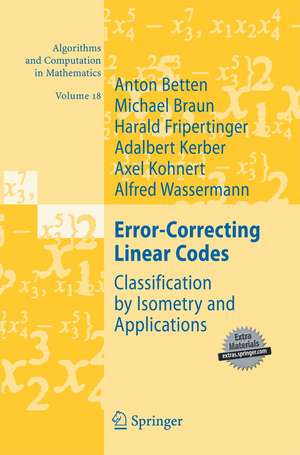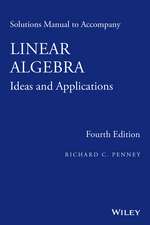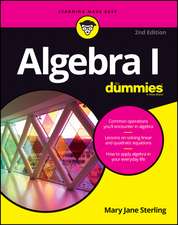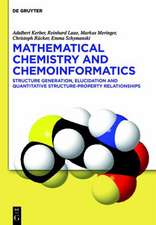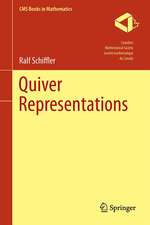Error-Correcting Linear Codes: Classification by Isometry and Applications: Algorithms and Computation in Mathematics, cartea 18
Autor Anton Betten, Michael Braun, Harald Fripertinger, Adalbert Kerber, Axel Kohnert, Alfred Wassermannen Limba Engleză Paperback – 23 noi 2014
| Toate formatele și edițiile | Preț | Express |
|---|---|---|
| Paperback (1) | 497.22 lei 6-8 săpt. | |
| Springer Berlin, Heidelberg – 23 noi 2014 | 497.22 lei 6-8 săpt. | |
| Hardback (1) | 673.45 lei 6-8 săpt. | |
| Springer Berlin, Heidelberg – 29 aug 2006 | 673.45 lei 6-8 săpt. |
Din seria Algorithms and Computation in Mathematics
- 15%
 Preț: 671.14 lei
Preț: 671.14 lei - 18%
 Preț: 728.91 lei
Preț: 728.91 lei - 15%
 Preț: 602.42 lei
Preț: 602.42 lei -
 Preț: 488.92 lei
Preț: 488.92 lei - 15%
 Preț: 643.00 lei
Preț: 643.00 lei -
 Preț: 405.06 lei
Preț: 405.06 lei -
 Preț: 402.00 lei
Preț: 402.00 lei - 18%
 Preț: 738.69 lei
Preț: 738.69 lei -
 Preț: 397.97 lei
Preț: 397.97 lei - 18%
 Preț: 1121.13 lei
Preț: 1121.13 lei - 20%
 Preț: 656.36 lei
Preț: 656.36 lei - 15%
 Preț: 479.22 lei
Preț: 479.22 lei -
 Preț: 397.38 lei
Preț: 397.38 lei - 15%
 Preț: 591.14 lei
Preț: 591.14 lei -
 Preț: 393.35 lei
Preț: 393.35 lei - 20%
 Preț: 330.42 lei
Preț: 330.42 lei - 18%
 Preț: 962.35 lei
Preț: 962.35 lei - 23%
 Preț: 638.33 lei
Preț: 638.33 lei - 15%
 Preț: 596.55 lei
Preț: 596.55 lei -
 Preț: 398.15 lei
Preț: 398.15 lei - 18%
 Preț: 786.98 lei
Preț: 786.98 lei - 15%
 Preț: 701.06 lei
Preț: 701.06 lei - 18%
 Preț: 756.99 lei
Preț: 756.99 lei - 20%
 Preț: 1153.97 lei
Preț: 1153.97 lei - 18%
 Preț: 965.52 lei
Preț: 965.52 lei - 20%
 Preț: 341.48 lei
Preț: 341.48 lei -
 Preț: 499.25 lei
Preț: 499.25 lei
Preț: 497.22 lei
Preț vechi: 584.96 lei
-15% Nou
Puncte Express: 746
Preț estimativ în valută:
95.16€ • 98.98$ • 78.56£
95.16€ • 98.98$ • 78.56£
Carte tipărită la comandă
Livrare economică 14-28 aprilie
Preluare comenzi: 021 569.72.76
Specificații
ISBN-13: 9783642421815
ISBN-10: 3642421814
Pagini: 832
Ilustrații: XXIX, 798 p.
Dimensiuni: 155 x 235 x 44 mm
Greutate: 1.14 kg
Ediția:2006
Editura: Springer Berlin, Heidelberg
Colecția Springer
Seria Algorithms and Computation in Mathematics
Locul publicării:Berlin, Heidelberg, Germany
ISBN-10: 3642421814
Pagini: 832
Ilustrații: XXIX, 798 p.
Dimensiuni: 155 x 235 x 44 mm
Greutate: 1.14 kg
Ediția:2006
Editura: Springer Berlin, Heidelberg
Colecția Springer
Seria Algorithms and Computation in Mathematics
Locul publicării:Berlin, Heidelberg, Germany
Public țintă
GraduateCuprins
Linear Codes.- Bounds and Modifications.- Finite Fields.- Cyclic Codes.- Mathematics and Audio Compact Discs.- Enumeration of Isometry Classes.- Solving Systems of Diophantine Linear Equations.- Linear Codes with a Prescribed Minimum Distance.- The General Case.
Recenzii
From the reviews:
"The theory of error-correcting codes is a … new addition to the list of mathematical disciplines. … This book contains 51 figures and 102 tables. … The book provides access to all results at a level which is proper for graduate students of mathematics and computer science as well as for researchers." (Zlatko Varbanov, Zentralblatt MATH, Vol. 1102 (4), 2007)
"This is a thorough treatment of the theory of error-correcting codes. … This book is remarkable because of the enormous amount of material presented (in a very lucid style), but also because of the great variety of mathematical disciplines used … . A beautiful book on applied mathematics!" (H. Mitsch, Monatshefte für Mathematik, Vol. 151 (3), 2007)
"The main object of the book under review is an error-correcting linear code. … a motivated reader can profit much from studying this monograph, which contains rich material in one of the rapidly developing areas. … The presentation of material is reader-friendly, arguments are clear and concise, numerous exercises are original and stimulating … . To sum up, the book under review can be strongly recommended to anyone interested in the topic." (Boris È. Kunyavskii, Mathematical Reviews, Issue 2008 h)
"The theory of error-correcting codes is a … new addition to the list of mathematical disciplines. … This book contains 51 figures and 102 tables. … The book provides access to all results at a level which is proper for graduate students of mathematics and computer science as well as for researchers." (Zlatko Varbanov, Zentralblatt MATH, Vol. 1102 (4), 2007)
"This is a thorough treatment of the theory of error-correcting codes. … This book is remarkable because of the enormous amount of material presented (in a very lucid style), but also because of the great variety of mathematical disciplines used … . A beautiful book on applied mathematics!" (H. Mitsch, Monatshefte für Mathematik, Vol. 151 (3), 2007)
"The main object of the book under review is an error-correcting linear code. … a motivated reader can profit much from studying this monograph, which contains rich material in one of the rapidly developing areas. … The presentation of material is reader-friendly, arguments are clear and concise, numerous exercises are original and stimulating … . To sum up, the book under review can be strongly recommended to anyone interested in the topic." (Boris È. Kunyavskii, Mathematical Reviews, Issue 2008 h)
Textul de pe ultima copertă
This text offers a thorough introduction to the mathematical concepts behind the theory of error-correcting linear codes. Care is taken to introduce the necessary algebraic concepts, for instance the theory of finite fields, the polynomial rings over such fields and the ubiquitous concept of group actions that allows the classification of codes by isometry. The book provides in-depth coverage of important topics like cyclic codes and the coding theory used in compact disc players.
The final four chapters cover advanced and algorithmic topics like the classification of linear codes by isometry, the enumeration of isometry classes, random generation of codes, the use of lattice basis reduction to compute minimum distances, the explicit construction of codes with given parameters, as well as the systematic evaluation of representatives of all isometry classes of codes. Up until now, these advanced topics have only been covered in research papers.
The present book provides access to these results at a level which is suitable for graduate students of mathematics, computer science and engineering as well as for researchers.
The final four chapters cover advanced and algorithmic topics like the classification of linear codes by isometry, the enumeration of isometry classes, random generation of codes, the use of lattice basis reduction to compute minimum distances, the explicit construction of codes with given parameters, as well as the systematic evaluation of representatives of all isometry classes of codes. Up until now, these advanced topics have only been covered in research papers.
The present book provides access to these results at a level which is suitable for graduate students of mathematics, computer science and engineering as well as for researchers.
Caracteristici
Well-written, applications-oriented textbook on coding theory based on earlier succesful German edition
